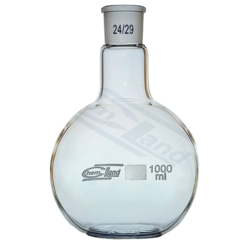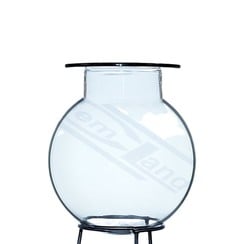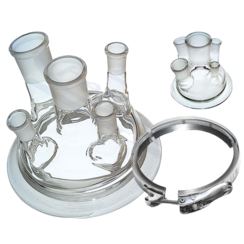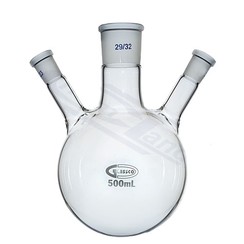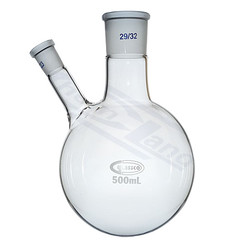You have no items in your shopping cart
Flasks
Flasks or distillation flasks are spherical pieces of glassware that are often used to carry out chemical reactions. They are available in many different variants. There are Flasks with a single neck, with 2 necks or 3 and more necks. A distinction is made between flat-bottomed and round-bottomed flasks. The advantage of flat-bottomed flasks is that they can stand on their own without falling over and can therefore be used directly on a heating plate or magnetic stirrer. The disadvantage of a flat-bottomed flask on a heating plate is that the heating is less well distributed than a round-bottomed flask in a jacket. Therefore, a round bottom flask is often preferred when performing distillations. A heating jacket distributes the heat evenly over the flask so that it heats up faster and less condensation takes place on the wall of the flask.
Most stocks have a standard ground joint, but this is not always the case. The advantage of standard grinding pieces is that they are easy to connect to other pieces of glassware with the same standard grinding piece. When using a multi-neck flask it is always important to plug any unused openings with a stopper. Grinding joints can be held in place by means of wire grinding clamps
A round bottom flask is also always preferred when distilling under reduced pressure. Because the flask is round, the pressure is evenly distributed, so that the chance that the flask will break is smaller than with a flat-bottomed flask at the same pressure. It should also be taken into account that the larger the volume of the flask, the less resistant they are to reduced pressure.
In distillations, a flask is always used in combination with other pieces of glassware. Examples include condensers/coolers, attachments, thermometers and vacuum extensions.
To keep a stock in place, a tripod is often used, this is a metal plate and rod to which clamps can be mounted by means of cross sleeves.
When performing reactions or distillations in flasks, it is always important never to fill the flask completely. During a reaction, substances can react with each other unexpectedly quickly, creating a lot of bubbles or foam that can shoot out of the flask if there is not enough space to absorb this. Therefore, never fill a flask more than +- 60-70% of the maximum volume.
-Reaction vessel
A reaction vessel is in many ways the same as a normal flask, however there are a number of points that make it different from normal flasks. First, reaction vessels often have a thicker wall than regular flasks, making them more resistant to reduced pressure. The disadvantage of the thick wall is that they can withstand local heat less well. A reaction of should therefore never be heated from 1 side only, as this can cause cracks in the reaction vessel. Actually the only way to heat a reaction vessel is by means of a heating jacket that can distribute the heat evenly. Always heat and cool a reaction vessel (and flasks) slowly. Sudden temperature differences can cause the wall to crack. A flask or reaction vessel with a crack in it is not easy to repair and must almost always be replaced.
Another advantage of a reaction vessel is that they have a large opening of at least 10 cm. This makes it easy to fill and clean and it is also easy to place an overhead stirrer. Large heating mantles almost never contain a stirring function, so an overhead stirrer with propeller must be used. Special adapters are available to provide an airtight seal between the overhead stirrer and the reaction vessel.

